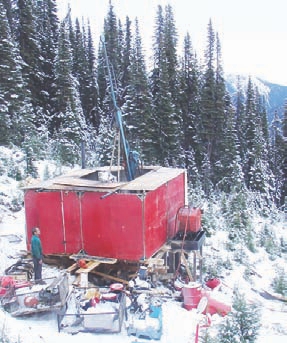VANCOUVER — The first resource estimate released by Mantle Resources (MTS-V, MTSZF-O) for its wholly owned Akie property has put the spotlight on a prospective mineral district in northeastern British Columbia that has seen little attention since mining companies exited the province to pursue global opportunities in the early 1990s.
Based on drilling data from fall 2005 to late 2007, Mantle has released an independent National Instrument (NI) 43-101-compliant inferred resource estimate of 23.6 million tonnes grading 7.6% zinc, 1.5% lead and 13 grams silver per tonne for the Cardiac Creek deposit on the Akie property. The estimate uses a base case cutoff grade of 5% zinc, within a series of tonnage estimates based on cutoff grades ranging from 2-7% zinc.
Drilling to date at Akie totals nearly 26,960 metres in 56 holes, of which 48 are within the resource model and used in the resource estimate. The remaining holes tested the mineralized horizon over a strike length of more than 6.5 km.
The newly released resource estimate is the first NI 43-101-compliant resource reported for any deposit in the Kechika Trough, the southernmost portion of the world-class Selwyn basin. That’s a point of pride for Mantle president Jim Mustard, who spent some of his early career as a geologist exploring similar geological terrain in neighbouring Yukon Territory.
“The Selwyn basin was an exploration hot spot in the ’60s and ’70s,” Mustard says. “This was a period when big oil companies were involved in mineral exploration in the region.”
The trigger for the historic exploration boom was the discovery of sedimentary exhalative (SEDEX) silver-lead-zinc deposits in the Yukon portion of the Selwyn basin in the 1950s. The British Columbia portion of the basin enjoyed a flurry of exploration then too, until the 1970s when a leftist anti-mining government pushed exploration companies back into the Yukon and Northwest Territories. While several SEDEX deposits discovered in the Yukon Territory (Faro, Grum, Vangorda) and Alaska (Red Dog) became profitable producers, the Kechika Trough has yet to achieve similar status.
Mustard says the lack of mines in the Kechika Trough isn’t for want for trying. Clifford Frame’s Curragh Resources outlined a historic resource of more than 50 million tonnes grading 7.8% zinc, 2.2% lead and 48 grams silver per tonne at the Cirque (formerly Stronsay) deposit and raised the profile of the region in the late 1980s and early ’90s before a series of corporate problems sidelined its efforts.
Teck Cominco (TCK. B-T, TCK-N) and partner Korea Zinc acquired Cirque from the bankruptcy proceedings of Curragh Resources, but have yet to reactivate the project. Inmet Mining (IMN-T, IEMMF-O) spent about $4.5 million to explore the Akie property from
1994 to 1996, only to drop it during the recent industry downturn.
In the 1990s, environmental groups tried to preserve as much wilderness as they could in the region, situated about 250 km northwest of the town of Mackenzie. Some new parkland was created, however the land-planning process specifically excluded areas with known mineral potential, including much of the Kechika Trough.
Ecstall Mining, which had previously optioned Akie to Inmet, kept the project in good standing through the downturn and in 2005, found a new joint-venture partner in Mantle Resources. Mantle eventually acquired Ecstall and now owns the project outright.
Infrastructure is much improved since the first exploration forays into the region, with forestry roads extending to within 10 km of the main targets at Akie.
Mantle’s recent exploration efforts have focused on the Cardiac Creek deposit, which occurs within a planar, steeply dipping sheet-like zone of semi-massive to massive sulphides comprised of varying amounts of pyrite, sphalerite and galena.
The deposit has been traced over a strike length of 6.5 km and a downdip extent of more than 800 metres. At the 5% zinc cutoff grade, the deposit has a strike length of about 900 metres and a dip length of 750 metres. The zone ranges in thickness from less than 1 metre to as much as 40 metres, and has an average true thickness of about 20 metres in the area of potential economic interest. This portion of the zone will be further tested by a proposed underground exploration program.
Mantle’s goals are to upgrade and expand resources within and around Cardiac Creek, and test other priority targets at the 54-sq.- km Akie property.
Mustard says the company has consulted with local First Nations on an ongoing basis, and is in the final stages of negotiating a memorandum of understanding to guide ongoing activities in the district.
Mantle has expanded its holdings in the Kechika Trough to more than 1,000 sq. km, and along with Teck Cominco, is now a dominant landholder in the evolving mineral district.
The company has 69.1 million shares issued and outstanding, roughly 10% of which are held by Lundin Mining (LUN-T, LMC-N).


Be the first to comment on "Mantle blazes new trail into historic Kechika Trough"